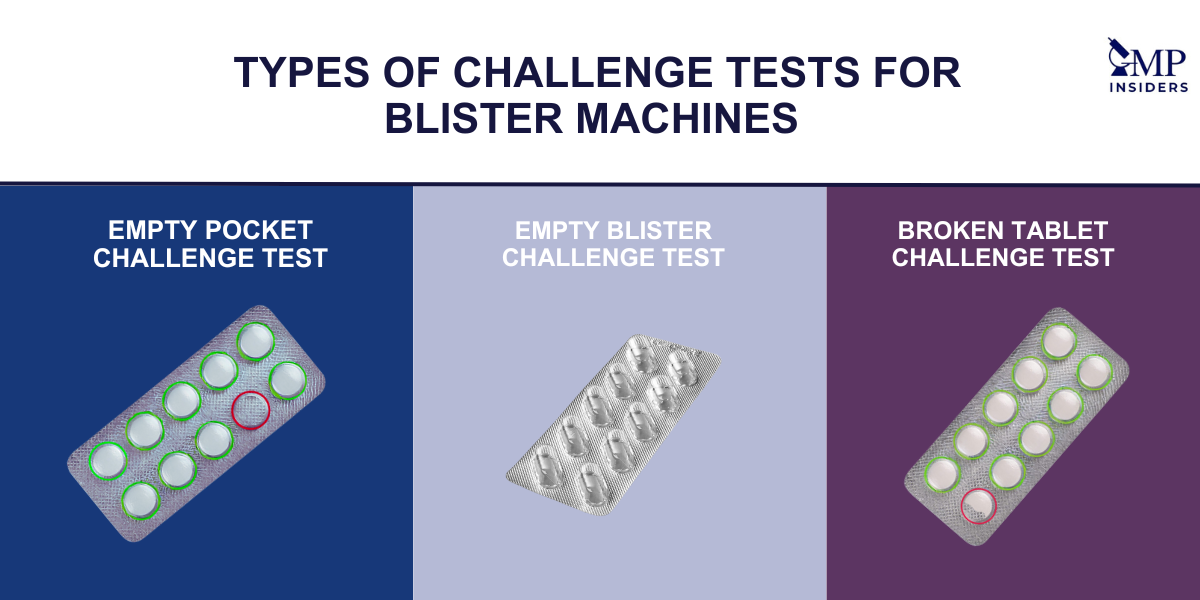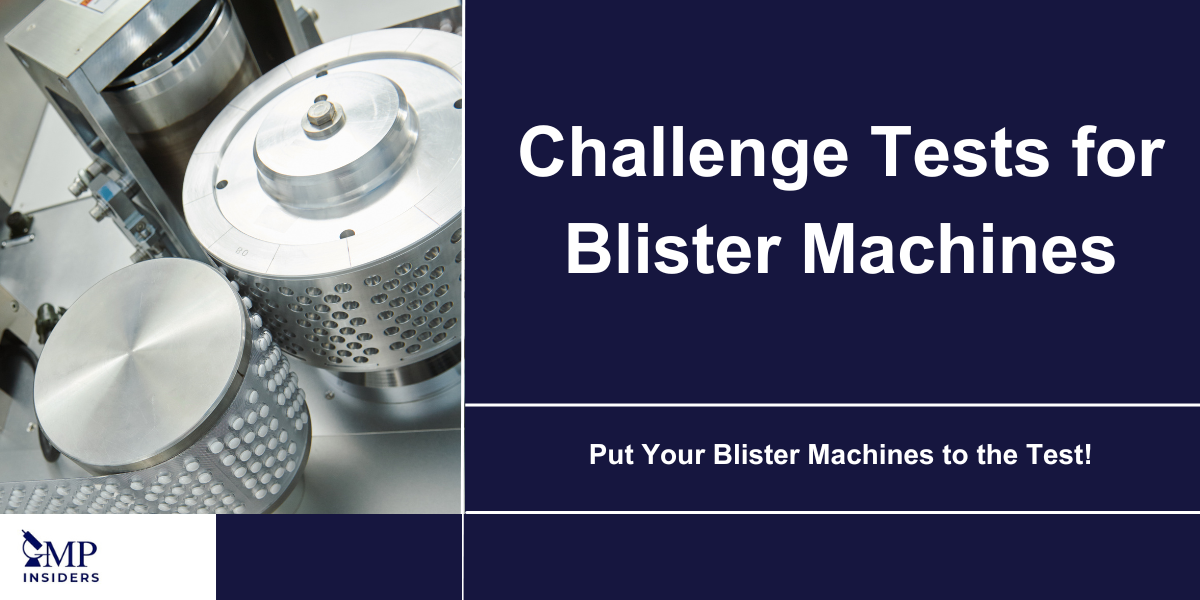Blister machines are commonly used in the pharmaceutical industry for packaging solid dosage forms, such as tablets, soft gelatine capsules, and hard gelatine capsules in the form of a blister. The packaging method includes a transparent plastic (PVC) or aluminum sheet and a base plate. A challenge test for blister machines is important because it ensures the packaging system’s effectiveness in detecting and rejecting defective or compromised blister packs, maintaining product quality and safety.
This article will delve into the most significant challenge tests used for blister packaging, each instrumental in ensuring the reliability of our quality control processes.
Understanding Blister Machines
There are many benefits when it comes to blister packaging, especially the protection of the product against environmental factors such as (moisture, microbiological contamination, and oxygen), also tamper resistance (this type of packaging increases patient safety), marketing benefits (blisters enhance the appearance of the product), compatibility with mass production, cost-effective production, easy to use with well-defined dosages.
RELATED: The Importance of Pharmaceutical Packaging
Today, blister machines can operate at a speed of ≤800 packages/min. The mechanism is pretty simple. The machine heats the plastic that, under the influence of the temperature, transforms into a blister cavity. The cavities are later loaded with the product and sealed with heat on the foil plate.

The blister packaging machines are made of the following parts:
Feeding Station – This Station is responsible for the supply of medication (tablets or capsules) to the blister-forming area.
Unwinding Station – the Station that carries the forming foil.
Forming Station – This Station contains the mechanical parts that create cavities in the foil, the cavities later are filled with the medication and have a desired shape that resembles the tablet or the capsule that is packed.
Filling Station – This Station, as the name suggests, fills the formed blister cavities with the product.
Sealing Station – the part where the filled blister packs and the backing foil meet and are sealed with the use of heat.
Cutting Station – is used to cut the blister to its appropriate size and separate it from the continuous packaging material.
Control system – evaluates the operation of the blister machine and with the use of the camera system removes any faulty blisters. It also controls and displays the temperature, pressure, and speed.
Embossing Station – used to emboss the lot number of the batch and the expiration date.
What Are the GMP Requirements When It Comes to Blister Packaging?
Blister packaging is part of the primary packaging of one medication, so the exact requirements need to be met when it comes to Good Manufacturing Practices for blister packaging.
Firstly, before the production process starts, all blister packaging equipment must be qualified, calibrated, and maintained according to GMP standards to ensure accurate and consistent performance. If the equipment successfully passes the evaluation by maintenance, it can be used for the production process.
Blister packaging facilities must be designed, constructed, and maintained in a manner that prevents contamination, cross-contamination, and mix-ups. There must not be any residues of any material from previous production processes.
All materials used in the production process must be sourced from approved suppliers, checked, and approved by the Quality Control laboratory. Any material or bulk product used for blister packaging, such as PVC foil, ALU foil, capsules, or tablets, must have a label with the name of the material or bulk product (identification), dosage form and strength, lot number, expiration date, quantity, and status “allowed for use.” This part also includes proper storage conditions for the material or bulk to prevent degradation, contamination, or other quality issues.
Personnel involved in blister packaging operations must receive adequate training on GMP requirements, standard operating procedures (SOPs), and hygiene practices.
Personal hygiene standards, including handwashing, gowning, and the use of protective clothing (masks, glasses, medical-grade gloves), should be strictly enforced to prevent contamination of products.
As with any other production process, blister packing undergoes validation, to ensure consistent product quality. Validation of a process includes: validation of equipment, facilities, software, storage, cleaning, temperature, speed, pressure etc.
Blisters must be properly closed and sealed and evaluated by a Quality Control laboratory with a vacuum leak test to ensure no contamination.
Types Of Challenge Tests for Blister Machines

Challenge tests are a crucial part of quality control in the pharmaceutical industry, and they serve to verify the functionality of the camera and the machine’s ability to identify and reject faulty blisters. This article will delve into the most significant challenge tests used for blister packaging, each instrumental in ensuring the reliability of our quality control processes.
Empty Pocket Challenge Test
As the name suggests, the Operator will purposely leave one pocket of the blister empty (without a product) and wait for the camera to detect the faulty blister. If the machine removes the blister, the test is passed.
Steps in Conducting the Empty Pocket Challenge Test
- Preparation
- Clean the blister packaging machine thoroughly.
- Calibrate the machine according to the manufacturer’s specifications.
- Ensure that the blister materials (foil, PVC, etc.) are properly loaded.
- Execution
- Operate the machine under normal production conditions.
- Introduce a predetermined number of empty pockets in the blister feed (this can be done manually or through a controlled defect introduction system).
- Run the machine and produce a batch of blister packs.
- Detection
- Inspect the produced blister packs for empty pockets.
- Use automated vision systems or manual inspection to detect empty pockets.
- Record the number and location of empty pockets in each blister pack.
- Analysis
- Analyze the inspection results to determine the machine’s accuracy and reliability in detecting and rejecting empty pockets.
- Identify any trends or patterns in the defects to pinpoint potential issues with the machine’s operation or materials.
Empty Blister Challenge Test
The name of the test suggests that this time, the Operator will leave an entire blister empty and wait for the camera to notice the defective blister. If the machine removes the blister, the test is passed.
Steps in Conducting the Empty Blister Challenge Test
- Preparation
- Ensure the blister packaging machine is clean, calibrated, and set up according to the manufacturer’s guidelines.
- Verify that all materials (e.g., blister foils, forming films) are correctly loaded and are of appropriate quality.
- Execution
- Manually introduce an empty blister pack into the feed or designate a specific blister to remain empty.
- Operate the blister packaging machine under normal production conditions.
- Detection
- Utilize the machine’s vision system or sensors to scan the blister packs as they pass through the inspection station.
- Ensure the system identifies the entirely empty blister pack as defective.
- Rejection
- Verify that the machine’s rejection mechanism successfully removes the empty blister pack from the production line.
- Manually inspect the rejected blister packs to confirm that the empty blister pack was correctly identified and removed.
- Analysis
- Analyze the performance of the vision system or sensors to ensure they function correctly.
- If the empty blister pack is not detected or rejected, conduct a root cause analysis to identify and rectify the issue.
Broken Tablet Challenge Test
To perform this test, the Operator intentionally adds a broken tablet inside one of the blisters and waits for the camera to detect it. If the machine removes the blister, the test is passed.
It is crucial to record and include the results of all challenge tests in the documentation of every batch.
Steps in Conducting the Broken Tablet Challenge Test
- Preparation
- Ensure the blister packaging machine is clean, calibrated, and set up according to the manufacturer’s guidelines.
- Verify that all materials (e.g., blister foils, forming films) are correctly loaded and of appropriate quality.
- Execution
- Intentionally place a broken tablet inside one of the blister pockets.
- Operate the blister packaging machine under normal production conditions.
- Detection
- Utilize the machine’s vision system or sensors to scan the blister packs as they pass through the inspection station.
- Ensure the system identifies the blister pack with the broken tablet as defective.
- Rejection
- Verify that the machine’s rejection mechanism successfully removes the blister pack with the broken tablet from the production line.
- Manually inspect the rejected blister packs to confirm that the pack with the broken tablet was correctly identified and removed.
- Analysis
- Analyze the performance of the vision system or sensors to ensure they are functioning correctly.
- If the blister pack with the broken tablet is not detected or rejected, conduct a root cause analysis to identify and rectify the issue.
Implementing Challenge Tests for Blister Machines
Before the Operator initiates any testing procedures, a few steps must be completed. First, the blister machine must be thoroughly cleaned and maintained according to manufacturer guidelines. There must not be any residue or debris that might affect the test results. The specific test parameters must comply with the requirements, such as temperature, speed, feeding, filling of the cavities, sealing pressure, and humidity.
The selection of test materials is a crucial part of every test. When it comes to challenge tests for blister, manufacturers can use:
Mockups: Simulations of the actual blister packaging components. They are usually used in process validation, initial testing, and equipment setup, as they allow testing without using the exact medication.
RELATED: Process Validation in GMP
Placebos: Mimic the appearance of the product, but it does not contain the actual medication.
Actual products: They provide the most accurate representation and ensure that any issues or challenges encountered during testing are directly relevant to the final product and its intended use.
Execution of Tests and Monitoring Techniques
The Operator must follow the testing protocol where the challenge test procedure and the frequency of the test is explained. The test frequency is usually at the start of a new batch.
Then, the worker must ensure that the temperature, pressure, and speed of the machine are adequate for the test requirements. The machine must be calibrated and in working condition. The machine display must be monitored closely during the test run, and any deviations must be reported immediately. All the data, including the test results, must be evaluated and stored in the documentation of the specific batch.
- When it comes to the monitoring, there is real-life monitoring of the Operator while the test runs. This includes temperature, speed of the process, humidity, and pressure.
- Camera and sensors – the camera evaluates every blister separately and removes the faulty blisters (empty blister, blister with a broken tablet, blister that lacks one or more tablets/capsules), sensors that display data for pressure, temperature, and speed.
- Visual inspection of the rejected blisters: If the machine is not recognizing the blisters correctly, it might reject a perfectly good blister that is not leaking, does not have a broken tablet, all cavities are filled with medication and has a correct lot number and expiry date.
- All the data collected from challenge test documentation must be evaluated to determine if there is variation in the results, patterns, and issues.
- If there are any deviations in the process, then Root Cause analysis is the next step to determine the cause of the problem.
Frequency of Challenge Test for Blister Machines
The frequency of the Challenge tests must be defined in the SOP. Usually, the test is performed before the start of a new batch (at the beginning of the production process), after a longer breakdown (a few hours), after calibration, change of the set parameters, or maintenance of the machine.
Improving and Optimizing Challenge Tests
Challenge tests are crucial for quality control of the blisters, but alone are not enough when it comes to the requirements of the pharmaceutical companies and GMP requirements.
Most of the time, blisters are also evaluated using vacuum leak testing. This test detects leaks in blisters by measuring the deflection of the blister surface in response to the applied vacuum. Nowadays, some systems combine visual challenge tests and vacuum leak tests in a single machine.
FAQ
What Are the Primary Components Tested During a Blister Machine Challenge Test?
Blister challenge tests are performed to inspect the camera of the blister packaging machine. If the camera system is working correctly, defective blisters will be detected and rejected.
How Often Should Challenge Tests Be Performed on Blister Machines?
The frequency is defined in the SOP, usually at the beginning of a new batch and after a more extended breakdown.
What Happens If a Blister Machine Fails a Challenge Test?
If the machine fails a challenge test, the Operator must report the deviation, and the machine and the test results must be evaluated. The production process must only continue once the machine passes the challenge test.
Can Challenge Test Results Be Used to Improve Machine Performance?
Yes, they can. All the data collected from the challenge tests will be evaluated. Any variations, issues, or deviations will be analyzed to reduce their frequency and improve machine performance and reliability.
Conclusion
Blister packaging is an essential aspect of pharmaceutical production, ensuring that solid dosage forms like tablets and capsules are securely protected from environmental factors while maintaining patient safety.
The integrity and efficiency of blister machines are critical, necessitating rigorous challenge tests to uphold quality control standards. Tests such as the Empty Pocket Challenge Test, Empty Blister Challenge Test, and Broken Tablet Challenge Test play vital roles in verifying the functionality of blister packaging machines. These tests help in detecting and rejecting faulty blisters, thus preventing compromised products from reaching the market.
By adhering to current Good Manufacturing Practices (cGMP), maintaining and calibrating equipment, and conducting regular challenge tests, pharmaceutical companies can ensure consistent product quality and safety. Furthermore, the implementation of challenge tests and the analysis of their results are instrumental in identifying and rectifying potential issues, leading to continuous improvement in machine performance.














